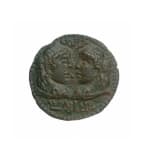Artuqid Bronze Dirham of Najm al-Din Alpi bin Timurtash, 1152 CE - 1176 CE
Bronze
14.2 Grams
C.6986
Obverse: Two Male Busts in Profile Facing Each Other; Inscription 'Necmeddin, Melik Diyarbekir' Reverse: The Virgin Crowning a Byzantine Emperor; Inscription 'Ebu'l Muzaffer Alpi bin Timurtas bin Ilgazi bin Artuk'...
Obverse: Two Male Busts in Profile Facing Each Other; Inscription "Necmeddin, Melik Diyarbekir"
Reverse: The Virgin Crowning a Byzantine Emperor; Inscription "Ebu'l Muzaffer Alpi bin Timurtas bin Ilgazi bin Artuk"
The Artuqid Dynasty was founded by Artuq, an Oghuz Turk who originally served as a general in the army of the Seljuk Sultan of Damascus. After proving his worth on the battlefield, Artuq was appointed governor of Jerusalem after it was captured by the Seljuks in 1086. Five years later, Artuq passed away and was succeeded by his sons Sokman and Ilghazi who continued to rule Jerusalem until 1098 when the Fatimids gained control of the city. Sokman and Ilghazi fled the Holy Land and established new bases of power in the cities of Diyarbakir, Mardin, and and Hasankeyf in Southeastern Turkey. Here, they came into conflict with the Crusaders. At various times, the Artuqids allied themselves with the Great Seljuks while at other times they opposed the Seljuks. Later on, they would join forces with the great Ayyubid Sultan Saladin. Over time, the Artukids broke apart into separate branches as their influence began to wane under the Ayyubid’s power and their ruled in name only. After attempting to form an alliance with the Sultanate of Rum, the Hasankeyf branch was destroyed by the Ayyubids in 1231. The Mardin branch lasted a while longer, but only as a vassal of a string of neighboring powers including the Ayyubids, the Sultanate of Rum, and the Timurids until finally falling to the forces of Karakoyunlu in 1409.
The Artuqids issued a series of autonomous coinage modeled not on contemporary Arab examples, but on earlier Greek, Roman, and Byzantine issues which had not been in circulation for several centuries at least. The obverse of this coin is based on Roman coins that featured two draped male busts. The reverse, however, follows a Byzantine type issued by Romanus III and Constantine X depicting the emperor being crowned by the Virgin Mary. It is thought that the iconography of this coin has an astrological meaning, with the two busts on the obverse representing the Gemini twins while the reverse may depict allegorical representations of Mercury as the emperor and Virgo as the Virgin.
Reverse: The Virgin Crowning a Byzantine Emperor; Inscription "Ebu'l Muzaffer Alpi bin Timurtas bin Ilgazi bin Artuk"
The Artuqid Dynasty was founded by Artuq, an Oghuz Turk who originally served as a general in the army of the Seljuk Sultan of Damascus. After proving his worth on the battlefield, Artuq was appointed governor of Jerusalem after it was captured by the Seljuks in 1086. Five years later, Artuq passed away and was succeeded by his sons Sokman and Ilghazi who continued to rule Jerusalem until 1098 when the Fatimids gained control of the city. Sokman and Ilghazi fled the Holy Land and established new bases of power in the cities of Diyarbakir, Mardin, and and Hasankeyf in Southeastern Turkey. Here, they came into conflict with the Crusaders. At various times, the Artuqids allied themselves with the Great Seljuks while at other times they opposed the Seljuks. Later on, they would join forces with the great Ayyubid Sultan Saladin. Over time, the Artukids broke apart into separate branches as their influence began to wane under the Ayyubid’s power and their ruled in name only. After attempting to form an alliance with the Sultanate of Rum, the Hasankeyf branch was destroyed by the Ayyubids in 1231. The Mardin branch lasted a while longer, but only as a vassal of a string of neighboring powers including the Ayyubids, the Sultanate of Rum, and the Timurids until finally falling to the forces of Karakoyunlu in 1409.
The Artuqids issued a series of autonomous coinage modeled not on contemporary Arab examples, but on earlier Greek, Roman, and Byzantine issues which had not been in circulation for several centuries at least. The obverse of this coin is based on Roman coins that featured two draped male busts. The reverse, however, follows a Byzantine type issued by Romanus III and Constantine X depicting the emperor being crowned by the Virgin Mary. It is thought that the iconography of this coin has an astrological meaning, with the two busts on the obverse representing the Gemini twins while the reverse may depict allegorical representations of Mercury as the emperor and Virgo as the Virgin.



